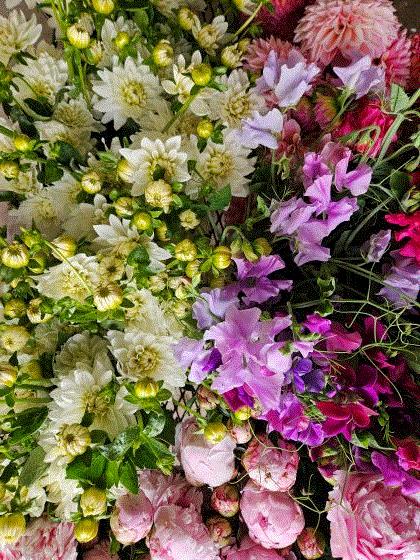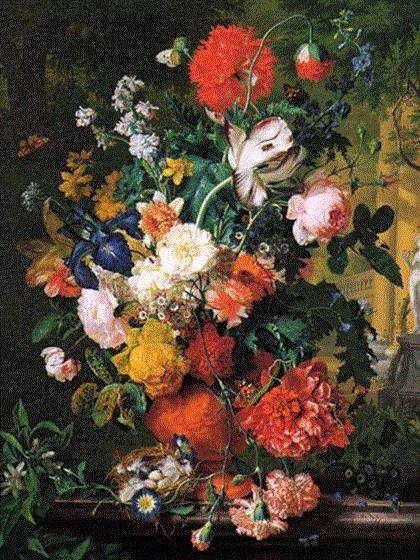June Farm Update: "Beautiful Chaos"

Dahlias, sweet pea and peonies—what a dream!
June is a fun season on the farm—it can be a blending of the seasons when we get the crop planning right. Thankfully, this season is a harmonized medley of ranunculus, stock, snapdragon, sweet pea, peonies and even hothouse dahlias!
Our florist clients were thrilled and even somewhat taken back by having dahlias and peonies at the same time. They don’t overlap every season, but when they do ... Tater and I think they are a winning combination (not to mention every bride’s dream)!
When we’re not swimming in blooms, we are hastily rolling out drip tape, laying plastic mulch and plumbing water lines to take care of our outdoor fields. June is beautiful chaos. We’re hedging our bets that the long hours and daily grind will pay dividends in August and September. I’m optimistic and hopeful, but I suppose that is what keeps me in the business.
Tater and I hope your spirits are as high as ours. My best advice to you is to make sure that you are taking care of yourself during peak planting season. One of my life-saving tips is to pack yourself a snack for the field every day—no exceptions. I know this sounds simple, but that small act of preparation will make you more agreeable when 3 p.m. rolls around. Your crew, spouse and beloved farm pup will thank you later—trust me!
In this edition of Bloom Beat, we’re talking about peony storage, a new Floral Standards book and more. With all that being said, let’s talk shop!

Sub-zero Peony Storage?

Tater and I are just wrapping up peony season. We had a bumper crop this year!
Tater and I had a bumper crop of peonies this season thank to our more than 1,500 plants. Each year, we've planted a couple hundred roots and eventually it turned into this!
Many folks are planting peonies to jump-start their flower farms and it may be worth thinking about how to extend your season. Peonies can be stored for as long as sixteen weeks if handled correctly and depending on the application. So Tater and I decided to take a deep dive into peony storage.
Peonies have a short season. Tater and I are lucky to have a month’s worth of peony sales by wet-packing them and storing them in our normal cooler. Standard cooling storage at 33-39F can effectively hold peonies for up to eight weeks. Be careful, though, because peony vase life is reduced the longer they are in storage. That’s why we try to sell them as quickly as possible!
But what if we could store peonies at 32F or lower? My dear friend Dr. Nathan Jahnke of Ball Seed wrote his PhD dissertation on this exact topic.
Peonies have thick petals and sturdy stems, making them or a poster child for this experiment. Cold storage slows down the flower’s metabolism, essentially creating a stasis-like state. This stops the flower from aging and preserves the carbohydrates and water inside of the bud. What if we could slow this clock down to almost zero?
Dr. Jahnke and Dr. John Dole published
THIS ARTICLE in November 2020. According to them, peonies could tolerate sub-zero temperatures since peony buds are naturally high in starch. Previous research shows the breakdown of starches into other carbohydrates and using a pulsing solution before storage may lower the freezing point of the flowers. The researchers ran two experiments to test the effects of sub-zero storage temperatures on peonies compared to standard industry storage, and whether pre-storage pulses helped preserve the quality of the peony when stored over a long period of time. They tested ‘Festiva Maxima’ (FM), ‘Monsieur Jules Elie’ (MJE), and Sarah Bernhardt (SB) in various temperatures and solutions.
I recommend reading the
ARTICLE in its entirety—it's fascinating. But the CliffsNotes are as follows:
- Stems stored at -.6 C (or 30.9F) were stored for sixteen weeks with minimal sacrifice in appearance.
- ‘Festiva Maxima’ and ‘Monsieur Jules Elie' stems stored at -.6 C for sixteen weeks matched the vase life of fresh peony stems—which is amazing!
- Challenges with sub-zero temperatures include a risk of deformities or incomplete opening. This may be variety dependent.
Sub-zero storage shows promise for extending the local peony season and eliminating supply chain gaps for peonies in the future. Tater and I would love to hear from growers who store their peonies at sub-zero temps? Drop us a line at
ldaschner@ballpublishing.com.
If you don’t have a cooler that can chill to less than 32F, you can still dry store peonies with your standard cooler. But don’t expect to hold them for sixteen weeks. It will buy you some time, though, and will help stagger your crop and extend your selling window. Here are some pro tips:
- Harvest your peonies in the marshmallow stage—meaning when the petals are still closed but you can feel a soft squish in the bud when you squeeze it. Make sure blooms are dry when you cut them. Wet peonies are prone to mold.
- Strip bottom leaves off of each stem. This reduces the risk for botrytis.
- Lay bunches on their side in a ventilated crate. Air movement is important for dry storage.
- Wrapping bunches paper is also a great option, but I have seen folks dry store peonies without paper.
- Keep relative humidity high so the petals do not burn and dry out, but remember, keep the petals dry!
- When you are ready to rehydrate, cut stems underwater, place in hydration solution and let them drink for a minimum of 12 hours.

Floral Standards: Seattle Wholesale Growers Market
The Seattle Wholesale Growers Market (SWGM) has an exciting new release to add to your bookshelf. Founded in 2011, the SWGM is a farmer-owned cooperative that serves florists, designers and retail buyers in the Pacific Northwest. SWGM is the model flower coop and is one of the driving forces for the Slow Flowers movement.
This 336-page guide tells you everything you need to need to know about harvesting and storing more than 230 cut flower crops. Consider this your crash course to postharvest handling.
Originally, the SWGM started compiling material to create quality and product standard for the bunches on their market floor. Over the years, it turned into this handy book. Each crop has a spec sheet detailing ideal harvest stage, postharvest care and handling, vase life and variety recommendations. Tater and I are especially eager to look at the dahlia section! The SWGM worked with Dr. John Dole from NC State to conduct vase life tests for all the flowers in their book—especially the dahlias!
You can purchase the book directly from the Seattle Wholesale Growers Market
HERE.

Rachel Ruysch: Nature into Art

One of Rachel Ruysch's incredible paintings. They are breathtaking in person.
I am lucky that Toledo, Ohio, is my hometown, as it is home to one of the top-ranked art museums in the country, the Toledo Museum of Art.
USA Today ranked TMA the Best Art Museum in the USA this year.
The Toledo Museum of Art was practically in my backyard. Growing up, I spent countless weekends marveling at the Claude Monet and Vincent van Gogh paintings and the various traveling exhibits that graced our humble little city. So naturally I was thrilled when TMA announced they were hosting a comprehensive Rachel Ruysch exhibit. If you are a flower fanatic and art lover this exhibit is worth making the trek to see!
Rachel Ruysch (1664-1750) was a Dutch still-life painter who created extraordinary floral paintings. Her 350-year-old work mirrors current floral trends and the Slow Flowers movement. Each painting on display showcases incredibly detailed arrangements and botanically correct blooms.
But upon closer inspection, one can appreciate the whimsical nature of Rachel's work. Not only does she capture the fleeting beauty of here-today, gone-tomorrow flowers, she captures how the natural world interacts with the floral arrangements that grace our homes. Each canvas tells a dynamic story of how flowers enhance the lives of all living things.
Her personal story adds a layer of intrigue to her creations. Rachel showed incredible promise as a still-life painter at seventeen years old, and her talent continued to grow as she matured. She served as a court painter to Johann Wilhelm, Elector Palatine. She eventually became one of the highest paid artists of her era. Not only that, but she raised 10 children, AND she even won the Dutch lottery—twice!—one time winning the equivalent of more than $700,000.
Rachel continued to paint well into her eighties and her final works showcased an eclectic mix of flora and fauna. I cherish the forget me nots that graced her canvases towards the end of her career.
“This exhibition not only celebrates Rachel Ruysch’s stunning artistry but also reflects the Toledo Museum of Art’s ongoing commitment to broadening the narrative of art history,” said TMA's Adam Levine. “Ruysch’s legacy as a trailblazer and innovator is one that resonates deeply today, and we are honored to share her work with our visitors.”
Rachel Ruysch's work will be on display at TMA until July 27. If you are in the area, give me a shout! Tater and I are just over the Michigan border and would love to hear your thoughts on the exhibit. I hope you cherish it as much as I did.


Until next time,
Lindsay Daschner (and Tater)
Editor-at-Large—Bloom Beat
Owner—Forget-Me-Not Farms
This email was received by 6,263 of your fellow fresh-cut flower growers!
If you're interested in advertising in Bloom Beat, contact Kim Brown and she will hook you up!